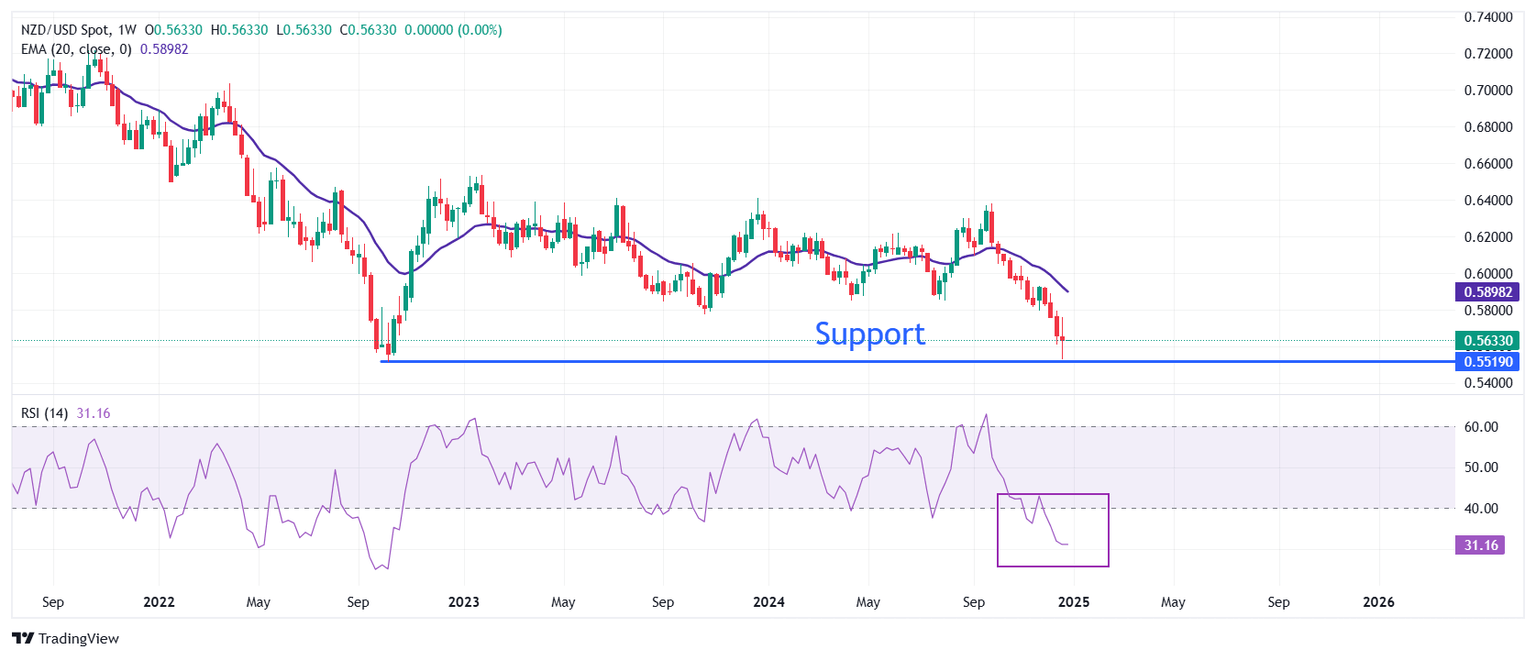NZD/USD Price Forecast: Wobbles around two-year low of 0.5300
- NZD/USD gains to near 0.5630 as the US Dollar ticks lower in a thin trading volume day.
- The Fed is expected to cut interest rates two times next year.
- Investors expect that the RBNZ will cut interest rates by 50 bps in February.

The NZD/USD pair moves higher to near 0.5630 in Friday’s North American session. The Kiwi pair gains as the US Dollar (USD) drops in a holiday-thinned trade. The US Dollar Index (DXY), which tracks the Greenback’s value against six major currencies, ticks lower to near 107.90.
The near-term outlook for the Greenback remains firm, as the Federal Reserve (Fed) has guided a more gradual rate-cut approach for 2025. A recent Fed dot plot showed that policymakers collectively see Federal Fund rates heading to 3.9% by the end of 2025, suggesting that there will be two interest rate cuts of 25 basis points (bps) next year.
Meanwhile, the broader outlook for the New Zealand Dollar (NZD) remains weak, as the Reserve Bank of New Zealand (RBNZ) is expected to continue aggressively reducing interest rates. The NZ economy sank into a recession in the third quarter, fueling the need for more interest rate cuts.
The RBNZ has already reduced its key Official Cash Rate (OCR) by 125 bps this year and is expected to cut further by 50 bps in the policy meeting in February.
NZD/USD finds a temporary cushion near the two-year low of 0.5520 on a weekly timeframe. The outlook of the Kiwi pair remains bearish as the 20-week Exponential Moving Average (EMA), which trades around 0.5900.
The 14-week Relative Strength Index (RSI) slides to near 30.00, suggesting a strong bearish momentum.
The Kiwi pair could decline to near the four-year low of 0.5470 and the round-level support of 0.5400 if it breaks below the psychological support of 0.5500.
On the other hand, a decisive break above the November 29 high of 0.5930 could drive the pair to the November 15 high of 0.5970 and the psychological resistance of 0.6000.
NZD/USD daily chart
New Zealand Dollar FAQs
The New Zealand Dollar (NZD), also known as the Kiwi, is a well-known traded currency among investors. Its value is broadly determined by the health of the New Zealand economy and the country’s central bank policy. Still, there are some unique particularities that also can make NZD move. The performance of the Chinese economy tends to move the Kiwi because China is New Zealand’s biggest trading partner. Bad news for the Chinese economy likely means less New Zealand exports to the country, hitting the economy and thus its currency. Another factor moving NZD is dairy prices as the dairy industry is New Zealand’s main export. High dairy prices boost export income, contributing positively to the economy and thus to the NZD.
The Reserve Bank of New Zealand (RBNZ) aims to achieve and maintain an inflation rate between 1% and 3% over the medium term, with a focus to keep it near the 2% mid-point. To this end, the bank sets an appropriate level of interest rates. When inflation is too high, the RBNZ will increase interest rates to cool the economy, but the move will also make bond yields higher, increasing investors’ appeal to invest in the country and thus boosting NZD. On the contrary, lower interest rates tend to weaken NZD. The so-called rate differential, or how rates in New Zealand are or are expected to be compared to the ones set by the US Federal Reserve, can also play a key role in moving the NZD/USD pair.
Macroeconomic data releases in New Zealand are key to assess the state of the economy and can impact the New Zealand Dollar’s (NZD) valuation. A strong economy, based on high economic growth, low unemployment and high confidence is good for NZD. High economic growth attracts foreign investment and may encourage the Reserve Bank of New Zealand to increase interest rates, if this economic strength comes together with elevated inflation. Conversely, if economic data is weak, NZD is likely to depreciate.
The New Zealand Dollar (NZD) tends to strengthen during risk-on periods, or when investors perceive that broader market risks are low and are optimistic about growth. This tends to lead to a more favorable outlook for commodities and so-called ‘commodity currencies’ such as the Kiwi. Conversely, NZD tends to weaken at times of market turbulence or economic uncertainty as investors tend to sell higher-risk assets and flee to the more-stable safe havens.
Author

Sagar Dua
FXStreet
Sagar Dua is associated with the financial markets from his college days. Along with pursuing post-graduation in Commerce in 2014, he started his markets training with chart analysis.


















